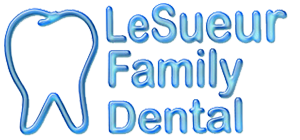When should your child first see a Le Sueur dentist? Expert Le Sueur dentists say the ideal time is six months after the first tooth erupts.
At this time, the dentist can provide or recommend information on baby bottle tooth decay, infant feeding practices, mouth cleaning, teething, pacifier habits, and finger-sucking habits.

Prepare your child
If possible, schedule morning appointments with a Le Sueur dentist, when young children are alert and fresh.
Prepare a preschooler or older child for the visit by giving him or her a general idea of what to expect. Explain why it is important to go to the dentist. Build excitement and understanding.
Prepare yourself
Discuss your questions and concerns with the dentist before the exam. Remember that your interpretations and expectations toward dental visits can be quite different from your child’s. Be honest with your view of the dentist. If you have dental anxieties, be careful not to relate those fears or dislikes to the child. Parents need to provide moral support by staying calm while in the dental exam room. Children can pick up parents’ anxieties and become anxious themselves.
Prepare the dentist
At the first visit, provide your Le Sueur dentist with your child’s complete medical history. For a restoration visit, such as getting a cavity filled, tell the dentist if your child exhibits stubborn, defiant, hysterical, or fearful traits in other life experiences.
Analyze your child’s reactions. Many parents are able to anticipate their child’s possible response to certain situations and should inform the dentist. Certain behavior traits may be linked to the age of your child:
- 10 to 24 months.Some securely attached children may experience developmental separation and become upset when taken from their parents for an exam.
- 2 to 3 years.A securely attached child may be able to cope with a brief separation from parents. In a 2-year-old, “no” may be a common response.
- 3 years. Three-year-olds should not be expected to accept separation from their parents for restoration treatment procedures, such as getting a cavity filled. This is because most 3-year-olds are not socially mature enough to separate from parents.
- 4 years.Most children should be able to sit separately from parents for exams and treatment procedures.
The first visit
Most initial office visits are to help acquaint the child with the dentist. The first dental visit is recommended at 6 to 12 months of age, or after several baby teeth have erupted. The first visit usually lasts 30 to 45 minutes and may include the following, depending on the age: a thorough examination of the teeth, jaws, bite, gums, and oral tissues to monitor growth and development, and, if needed, a gentle cleaning, which includes polishing teeth and removing any plaque, tartar and stains. The dentist may demonstrate proper home cleaning, including flossing, and assess the need for fluoride. Because baby teeth fall out, X-rays aren’t usually recommended for diagnosing decay. X-rays are used to see if the root of a jammed baby tooth may be affecting an adult tooth. In general, it is best not to use X-rays in young children unless absolutely necessary.
The second visit
Like adults, children should see the dentist every six months. Some dentists may schedule more frequent visits, every three months, to build comfort and confidence in the child, or to monitor a development problem.

